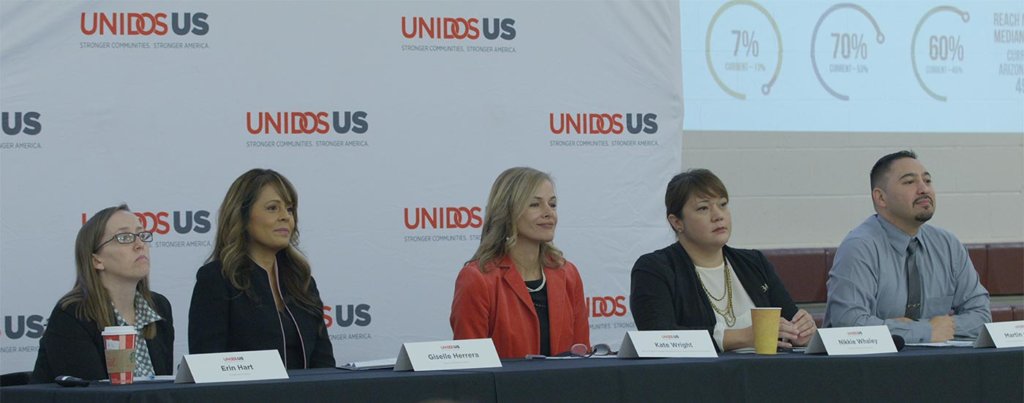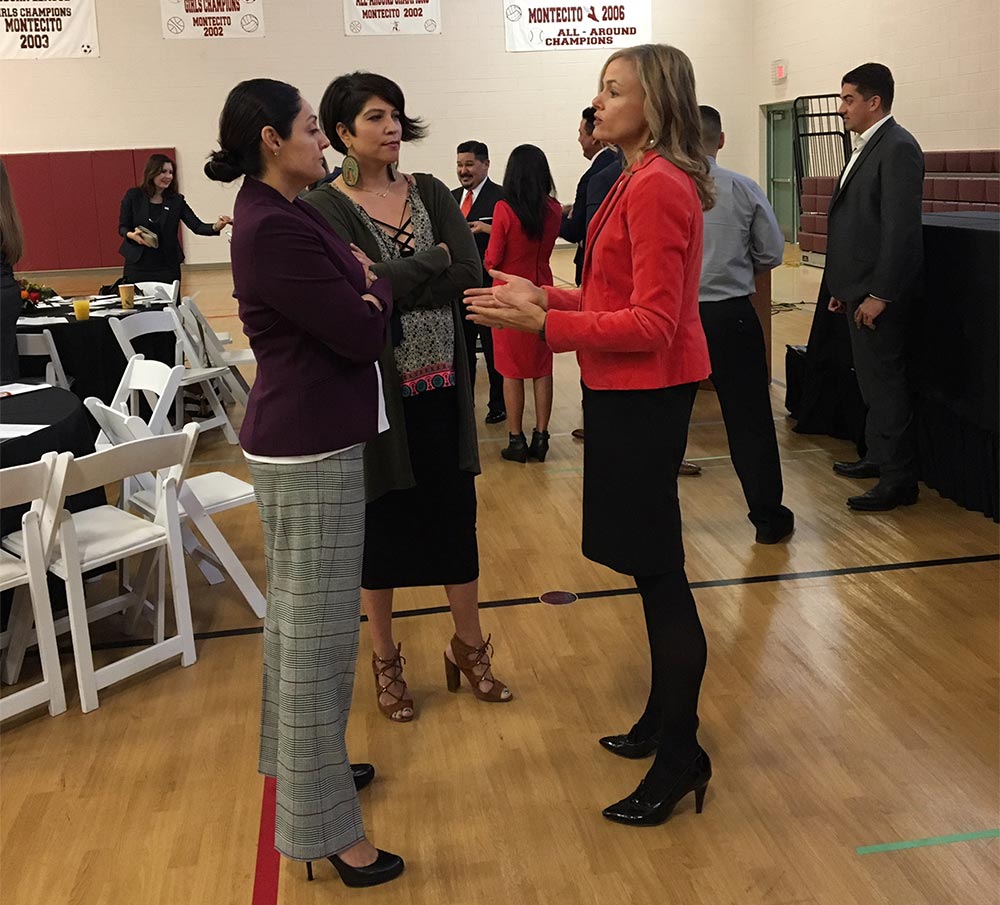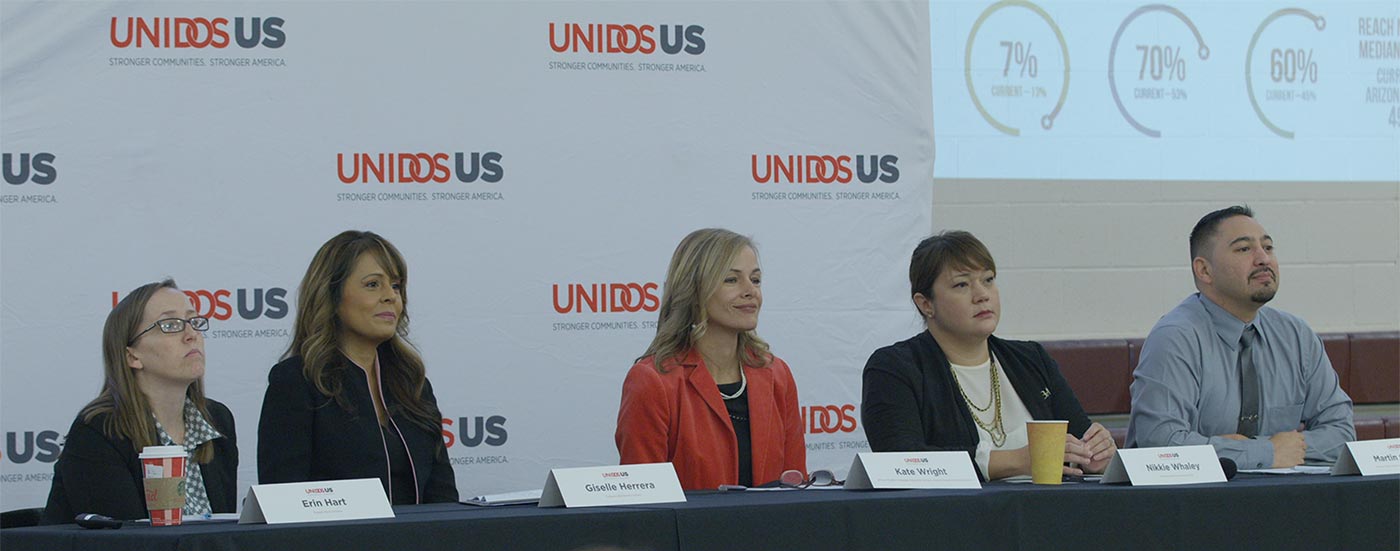Arizona’s Future Depends on Education Equity: UnidosUS Hosts Education Summit in Phoenix
Dozens of passionate education advocates came together last month during an UnidosUS education summit in Phoenix to consider what’s working and what isn’t for Arizona’s most vulnerable students, including low-income and minority students, students with disabilities, and the nearly 80,000 currently up in the state’s practice of segregating students learning English from their peers.

“What we can bring to the table, how can we work together and combine our assets in different ways?” UnidosUS Vice President of Policy and Advocacy Eric Rodriguez posed to attendees during his opening address.
UnidosUS convened the event to capture the perspectives of local partners on education and intersecting issues impacting schools and local communities leading into the 2019 state legislative sessions.
It also released a white paper called “Educational Fairness and Latino Success in the State of Arizona,” which explores gaps in Arizona’s implementation of the Every Student Succeeds Act (ESSA), the federal law governing equal access to K-12 education.
“This paper will serve as a beginning, foundational piece for discussion on education policy in Arizona and agenda-setting for UnidosUS leading up to the 2019 Florida legislative session,” said Callie Kozlak, UnidosUS’s field campaign manager for education policy and advocacy.

Equity and Accountability for Latino Student Success
UnidosUS advocates for accountability and culturally-responsive policy and program solutions to ensure Latinos and English learners receive the proper support for educational success in college and careers. ESSA is an important policy tool for this end because of its focus on collecting and reporting data on the academic performance of designated subgroups, such as English learners, and tying that to federal funding and action the state must take to support schools to better serve those students. As a civil rights organization, UnidosUS aims to see Arizona to align the state’s A-F school grading system to ESSA, which is in essence, a civil rights law to protect and advance historically underserved students against inequities.
Unique Challenges for Arizona’s English Learners
One of the biggest concerns was how to help the state’s English learners (ELs), who are currently graduating at a rate of just 18%, the lowest in the country, Kathy Hoffman, Arizona’s newly elected state superintendent of public instruction noted to attendants.
The current system, she told the audience, “is failing our students. We need to view their multilingualism as an asset and a benefit rather than a deficit.”
Arizona currently requires ELs that score below proficiency on the state’s assessment for English language proficiency, called AZELLA, to attend four-hour daily blocks of what it calls Structured English Immersion (SEI). Civil rights activists and education advocates have largely criticized this program. They say it prevents students from learning core academic content, which leads to lower achievement levels and higher drop-out rates.
And while just about all panelists said they would like to end this practice, they said any changes would likely take a few years due to necessary legislative and state constitutional changes, and encouraged the audience to stay vigilant.
“There’s some reluctance for educators and advocates to grasp that education is a political sport,” said Arizona Senate Member Martin Quezada. “I hear often from educators ‘I want to focus on the classroom and not the politics,’ and I always tell them, ‘if you do that, you’re failing your kids.’”
Quezada said there are many advocacy organizations lobbying on behalf of Latino students and parents and encouraged all stakeholders to engage them to ensure they’re up to date on current classroom issues.
Working Within the Current Laws
Panelists also encouraged teachers and school administrators to get creative within the confines of the current laws, even when they find them frustrating.
Kate Wright, the Deputy Associate Superintendent at the Arizona Department of Education’s Office of English Language Acquisition (OELAS), acknowledged that the SEI blocks can present significant barriers to graduation, and added that the folks in her department aren’t the ones making that law, just implementing it.
But she said, “even in a four-hour block there are innovative practices,” adding that policy makers and advocates could foster that by creating a collaborative teaching network with instructors from across the state.
Several panelists backed her up, noting that all classroom activities should be used as opportunities to merge core curriculum with critical thinking.
“A really good educator can meet the standards in an innovative way with their own minds,” said Nikki Whaley, board support and training specialist for the Arizona School Board Association, but she noted that obtaining the right resources and teachers to do so is a lengthy and demanding process.
And no matter what the subject, panelists said small, personalized initiatives can yield big results.

Robyn Mondragon, the principal of Phoenix’s Isaac Middle School, said she was bolstering programs for content recovery, meaning that if a student gets doesn’t get the right answer on an assignment the first time, they have an opportunity to review and try again later that day.
“We do it in a way that isn’t punitive and isn’t about harming them. It’s about saying, ‘look kids, we’ve got one job and that’s to make sure you’re ready for high school,’” she said.
Dr. Michael Robert, superintendent of the Osborn ES District, said it was important to make testing and data collection work for the benefit of each individual student.
“Most of our data tells us is where we failed, it’s deficit-minded conversation,” he said. “Fight to have conversations around data that let you know who your child is and what they need.”
He said the single most important assessment tool in his school district is an oral reading analysis, which involves a teacher sitting one on one with a child, having a conversation, learning what they’re able and not able to do, and tailoring instruction accordingly.
“If they’re lacking in something, you can actually have a conversation and guide them,” he said “That’s called teaching. That’s what we got into this for.”
“We believe that all children are capable of success, no exceptions, and no exceptions means no exceptions, seconded Lupita Hightower, Superintendent of the Tolleson ES District. She also said students need to be reminded that learning is not just something you do for a career but also for the betterment of one’s community, home, and family.
The Long-Game for Education in Arizona
Classroom content was the largest but not the only concern for panelists. They also noted that low teacher pay and extensive tax cuts had drastically reduced the quality of Arizona’s public education, creating greater gaps in equity and contributing to a perpetuation of negative stereotypes about Latinos.
New York City Department of Education Chancellor Richard Carranza, a former Arizona educator, said none of this should come as a surprise. He says U.S. public schools began with a two-tiered “learned” and “laboring” caste system for students and suggested there is plenty of data to suggest this system was operating according to plan.

“Check your evidence,” he said, noting that across the nation Black and Latino students aren’t reaching the same levels of achievement and White and Asian students. Even though 65 years have passed since the start of the civil rights movement, America’s public school system isn’t doing enough to give those groups the support they need to compete fairly.
Citing an example from his current state of New York, he noted that his administration has been working to remove incarcerated teenagers from Rikers Island, one of the nations’ largest prisons. In the process, his research team has discovered that 92% of those incarcerated youth—many of whom are children of color—are functionally illiterate and an estimated 60% of them have undiagnosed disabilities.
“There’s a real nexus to the school to prison pipeline,” he said. “Our time is now. It is a critical juncture in America. It’s time not to be passive. It’s time to get real about what our policy is.”
A Culture of Innovation
Dr. Curtis Acosta, an assistant professor of elementary and secondary education at the University of Arizona South, led the discussion on culture by reflecting on his career as a teacher in the Tucson Unified School District from 1995 to 2013. He noted that Latino students performed better in all subjects when their teachers and the materials they were reading reflected people like themselves. In fact, he said students participating in his school’s rigorous Chicanx and Latinx-oriented curriculum consistently graduated at a rate of 96%.
“This was the first time they were reading and finishing books in an English class because the literature was a mirror to them. The history class was connecting them to the lives of the parents and grandparents, and ancestors in a way that drove conversations with their families at home,” he said. “They were so engaged in school that they were hungry to share their excitement with those who mattered the most.”
In 2010, curriculums like this were met with tremendous resistance. That year, conservative Arizona lawmakers enacted a ban on ethnic studies, but in 2017, an Arizona judge overturned that ban on grounds that it was discriminatory and politically partisan.
Panelists from Arizona’s business community shared Acosta’s excitement for this decision. They said culturally inclusive curriculums promoted the kind of innovation and enthusiasm Arizona needs to grow its economy.
“We have a great opportunity to advance our state and our nation is we keep our investment strong. We Latinos are an asset to the community which is why we need to own our narrative and value our narrative, but also help others to understand the value that we bring to this community,” said Lisa Urias, managing partner at the Arizona-based business firm CoNecs North America.
Chris Camacho, president and CEO of the Greater Phoenix Economic Council said today’s business leaders and economists are keen on attracting well-trained and educated human capital, and that means ensuring investments are made in the public education system to develop that capital.
“The core ingredients of a healthy economy are our ability to export products and services, our ability to grow an entrepreneurial climate, our ability to intensify innovation, and our ability to educate the entire populace of our market,” he said. “You have to do all four.”
As a parent, a school board member, and a member of UnidosUS’ education team, I am hopeful that things will change,” UnidosUS Arizona Education Organizer Ylenia Aguilar told Progress Report after the event “I’m hopeful because we have a civil rights organization working with other education organizations and school leaders on the ground to promote educational equity in our state, and now we have buy in from the state’s business community. They know the future of Arizona’s economic development lies in the investment of our generation of Latino students and their success.”

